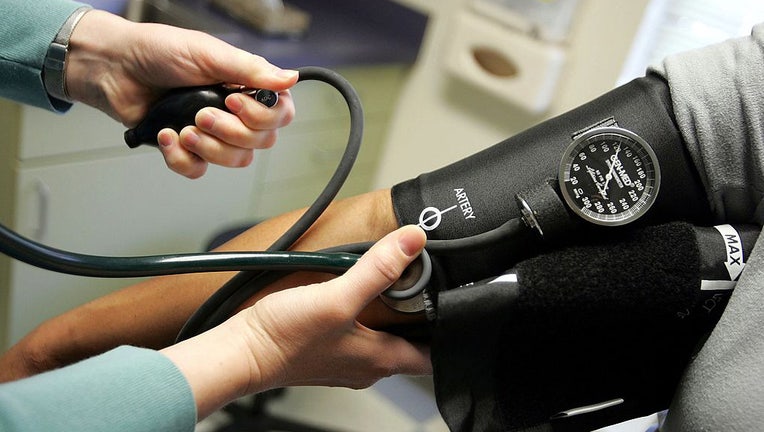Study: Daily 'breath training' helps reduce high blood pressure

FILE- A doctor reads a blood pressure gauge during an examination of patient. (Photo by Joe Raedle/Getty Images)
Exercise is one of the most effective ways to build muscle and stay healthy. But new research examines how training your breathing muscles can help lower your chances of high blood pressure.
Researchers at the University of Colorado worked with volunteers between the ages of 18 and 82 for their study to try a daily five-minute breathing technique using a device called PowerBreathe, a hand-held machine resembling an inhaler. When people breathe into the device, it provides resistance, making it harder to inhale.
RELATED: Napping could lead to high blood pressure, stroke, study suggests
Lead researcher Daniel Craighead, an integrative physiologist at the University of Colorado Boulder, told FOX Television Stations on Wednesday that the study revealed that the breathing device helps lower blood pressure.
"The main finding was lowering blood pressure. We did measurements of how healthy blood vessels are and we looked at cellular and molecular levels. We discovered that individuals’ arteries are functioning and healthier," Craighead said. He added that the research team observed test subjects who used the breathing device had lower blood pressure levels.
RELATED: 'Forever chemicals' linked to high blood pressure risk in middle-aged women, study finds
Craighead explains that the University of Colorado research builds on a previous sleep apnea study from the University of Arizona.
"Fiona Bailey, a professor from the University of Arizona, researched sleep apnea and noticed that some patients had lower blood pressure rates. So in conjunction with Dr. Bailey’s research, my team did the breathing study looking at ways to enhance your breathing to reduce high blood pressure."
"We looked at a device you can use when you inhale to help with your breathing. Thirty breaths a day needs to be done with some type of device to provide resistance," Craighead said. "These breathing devices are valves, and it's hard to get the intensity with breathing without the help of the device."
RELATED: Study: Teens' internet use linked to high blood pressure
Craighead offers additional breathing techniques that people can do if they don’t have a breathing device. "I think the main technique involves slow deep breathing, inhaling for four to five seconds and using six breaths a minute for exhaling, along with relaxation and slow breathing for 30-minute intervals each day."
The professor also explains that breathing techniques should be performed whether or not you have a device. However, it should not replace exercise, but complement it.
Surprising facts about high blood pressure
According to the Centers for Disease Control and Prevention (CDC), high blood pressure affects nearly half of adults in the United States. The agency explains that uncontrolled high blood pressure raises the risk for heart disease and stroke, which are the leading causes of death in the United States. Fortunately, high blood pressure is treatable and preventable.
The CDC lists five surprising facts regarding high blood pressure to be aware of.
High blood pressure could be linked to dementia: Recent studies show that high blood pressure is linked to a higher risk for dementia, a loss of cognitive function. Evidence suggests that having uncontrolled high blood pressure during midlife (ages 44 to 66) creates a higher risk for dementia later in life.
Young people can have high blood pressure, too: High blood pressure doesn’t just happen to older adults. Nearly 1 in 4 adults aged 20 to 44 have high blood pressure. High blood pressure is a leading cause of stroke, a condition that is on the rise among younger people. Experts think the increased risk for stroke in this age group is a direct result of the rising rates of obesity, high blood pressure, and type 2 diabetes—conditions that are preventable and treatable.
High blood pressure usually doesn’t have any symptoms: High blood pressure is sometimes called the "silent killer." Most people with high blood pressure don’t have any symptoms. Because many people feel fine, they don’t think they need to get their blood pressure checked. Even if you feel normal, your health may be at risk. Talk to your doctor about your risk for high blood pressure, according to the CDC.
Many people who have high blood pressure don’t know it: The CDC says that roughly 1 in 3 U.S. adults with high blood pressure aren’t even aware they have it and are not being treated to control their blood pressure. Although most people with uncontrolled high blood pressure have health insurance and visit a health care team member at least twice a year, the condition is often not diagnosed.7 CDC is working with health care professionals to find patients with high blood pressure who are "hiding in plain sight."
Women and African Americans face unique risks when it comes to high blood pressure: Women with high blood pressure who become pregnant are more likely to have complications during pregnancy than those with normal blood pressure. High blood pressure during pregnancy can harm a mother’s kidneys and other organs, and it can lead to premature delivery and low birth weight babies, according to the CDC.
Additionally, African American men and women have higher rates of high blood pressure than any other racial or ethnic group. These groups are also more likely to be hospitalized for high blood pressure. Medical professionals believe these health disparities are connected to higher rates of obesity and diabetes.
The CDC says to lower your risk, get your blood pressure checked regularly and take action to control your blood pressure if it is high.
This story was reported from Washington, D.C.

